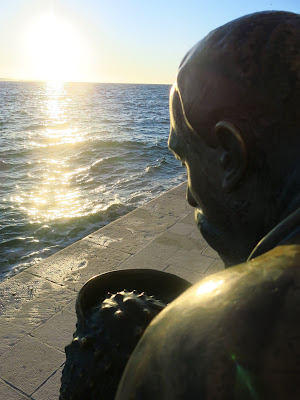Pag Town
(Photo Swiped from Wiki)
The pile of stone that one might mistake for Old Pag Town is, in fact, New Pag. Construction of New Pag began about 1443. Five hundred and seventy-four years ago. Prior to that, the people of Pag had been thoroughly defeated by the Zadarians, against whom they had revolted. Then came the threat of the Ottoman Turks. The new town was built three kilometers north of the older town of Pag, and construction was based on the "new" Venetian ideas of town planning. Old, New, it is all relative.
Pag Town feels like a ghost town for good reason. The population has been declining for more than a century. There are less than 3,000 souls living in the town. At the turn of the 19th-20th century, there were almost 5,000 folks here. Then came the vineyard blight, two world wars, and the Croatian War for Independence. Many of the former inhabitants of Pag emigrated to Canada and the United States. As an aside, such is also the case in some of the towns in southern Italy and Sicily. With nothing to do, the younger people are emigrating, leaving behind enclaves of aging villagers.
Paška čipka, the Famous Lace of Pag
In the stone center of Zadar, an hour to the south of Pag, you will see old women camped out along the shady side of the basilica. They will be tatting lace. How they do it without going completely crazy, as well as blind, I cannot tell you. Regardless, those pesky Zadarian women have stolen the lace making from the Pag folks. The famous lace is said to have originated in Pag Town.
Brekkie at the Hotel
This morning, the two other guests in the Frane Guesthouse rode away on their German motos. We were the only guests remaining in the hotel. Our very congenial host saw to our breakfast. Tended to a slow conversation as he trundled plates to our table, he told us of the battles with the salt winds. He spoke of trying to keep the roses and jasmine alive. He told us the Croatian names for the different winds, winds of the east and the south, but mostly the salt winds of the north.
We wandered around the dining room under his direction as he showed us his treasures. There were delicate examples of lace framed in shadow boxes, old maps, and faded photos. As we left, he and his family began setting up the room for yet another christening party. Or maybe a wedding. These private parties keep his business alive until the stream of tourists begins in June.
Looking into the Face of the North Winds
Truth be told, there really isn't much to do in Pag Town. One could walk every street and passage in the Old Town before lunch. During the high season, the walk would be a busy one. Now, in early May, the stones are quiet. You can almost feel the ghosts flitting about.
Sure, there are things to do, if one desires to do things. During the season there are fishing excursions, diving trips, tours of the cheese factories, and tours of the salt harvesting fields. There are the non-stop party meccas on the far north of the island. Or there is the quiet and complete repose of doing nothing in a very slow way. Pag came along at the end of our trip, our last days in Croatia. We couldn't have planned it better, especially considering that we did not plan it at all. Coming here was a fluke, a random finger on an electronic map.
No more Voyages
A coffee, a morning cigar, and no further desire.
Quiet Ghosts Walk Here
I did not take many photos in Pag. There were, I suppose, many things to take photos of. I simply forgot, immersed as I was in the sense of stillness. There was the ever changing sky, clouds to sun to rain to stars. But a photograph would not suffice. Four old men on a bench, the same old men that were on the same bench yesterday. You don't need a weather forecast in Pag. When the old men leave the bench, it is probably going to rain.
Quiet, so quiet that I swear one can hear the stones breathing. I do not believe I could stand it here during the high season. I don't mean to sound like a travel snob, but now that I have experienced Pag as a sleeping town, I could not bear it to see that quiet broken. Bless the summer tourist for coming here and keeping this place alive. And bless them for leaving, and leaving money behind, so that I can experience this magical pause before the storm.

















































